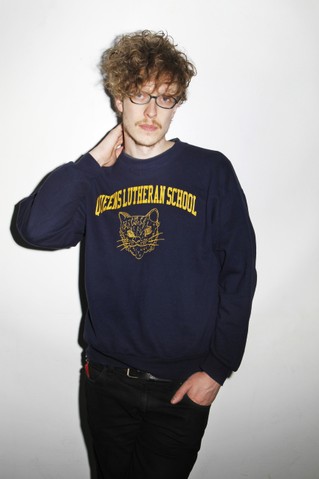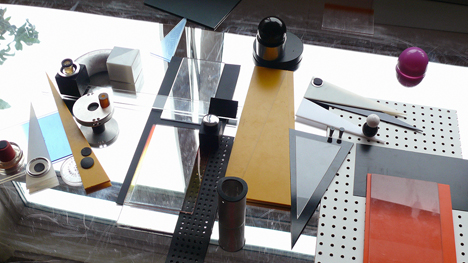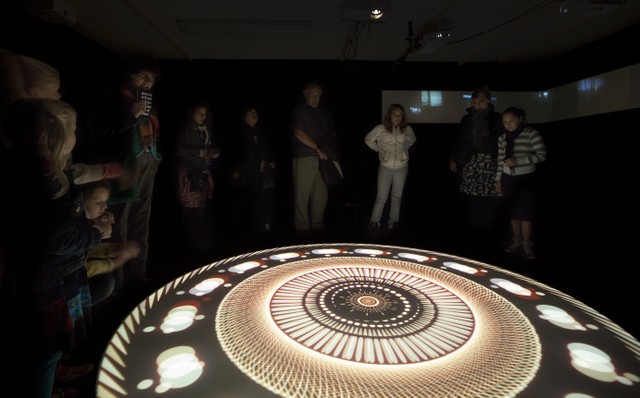MAX HATTLER
PEOPLEText: Mariko Takei
This year’s DOTMOV FESTIVAL 2010 has kicked off from November 1st. Among the selected works, SHIFT features a London-based artist Max Hattler, who made two different world that continues forever. One of them, “1925 aka Hell” will be also featured as a cover for this month issue of SHIFT. Max enthusiastically revealed about these selected works among other stories.

Photo: Miki Takahira
Could you introduce yourself?
Max Hattler. I’m an artist and director working primarily with animation. My work takes the form of video installations, short films and live audio-visual performances. I’m interested in the space between abstraction and figuration in the moving image where storytelling is freed from the constraints of traditional cinematic narrative.
How, when and where did you start to pursue your career as a media artist/filmmaker?
I was never all that much into film, which for a long time I only knew as narrative, live-action drama. Nor was I interested in animation, which I had only experienced as ‘cartoons’ – drawn funny films. I came to film in a roundabout way, through an interest in visual arts, design aesthetics, and the time-based media of sound and music. As a kid, I was always drawing and painting. I grew up in a musical family and in my teens I started using computers to make music, while also dabbling in computer graphics and animation. Perceiving these disciplines as disparate from each other, it took me a while until I realised that I had to combine them through the medium of animation film. I first started to do this while studying at Goldsmiths. But it wasn’t until my MA in Animation at the Royal College of Art that it all really came together for me as a coherent expression.
Many of SHIFT readers might remember that your work Collision (2005) was once selected for the DOTMOV FESTIVAL 2005. And this year 2 titles of your work were selected for the festival 2010. Could you introduce those 2 works? How did you come up with the idea? What is the main concept?
1923 aka Heaven and 1925 aka Hell are based on the intricately patterned paintings of French outsider artist Augustin Lesage, more precisely on two of his paintings made in 1923 and 1925, both called A symbolic Composition of the Spiritual World. Satisfying my appetite for patterning and abstraction, as well as the abstraction of ideas, Lesage’s work proved to be a rewarding starting point for an exploration of ideas around beauty, spirituality, eternity, and the cyclic nature of time. The ideal viewing environment for the two loops is as a double-projection installation. Played continuously on two opposing walls in a blacked-out room, they offer two simultaneous, differing visions of the spiritual world. As they inhabit the same physical space, their sounds and emanating light merge and overlap to create an immersive environment.
I directed the two loops during just five days in February 2010 at The Animation Workshop in Viborg, Denmark, where they were produced by a crew of excellent student animators and computer graphics artists. Looking at outsider art for inspiration, I came across Augustin Lesage. I was immediately hooked by his obsession with symmetry and repetition, combined with his spiritualist understanding of art. Lesage, a coal miner who picked up painting after an inner voice told him to do so, claimed never to have painted except under the explicit guidance of spirits, among them Leonardo da Vinci and Apollonius of Tyana. Being partial to patterns and mirroring myself, I liked the idea of transposing his vision of the spiritual world into a contemporary moving image context – updated through the lens of pop-cultural and art-historic references – using sound, image and movement to try and heighten the sense of the spiritual, while adhering to Lesage’s parameters of symmetry. The idea of a loop made perfect sense both in terms of a tableau vivant as well as an endless cycle – eternity – implicit in Lesage’s spiritual vision.
With all my work, I tend to feel my way from a tenuous starting point to the finished piece. Since making animated films is a slow process, I prefer not to storyboard but to keep things open-ended and let them develop organically. So for this project my aim was to do the same while working two groups of students. I gave each group one of the Lesage paintings and a set of instructions, and asked them not to discuss with the other group. I really wanted to develop two very different takes on Lesage with them. Lesage’s 1923 painting has a hint of perspective, so it seemed natural to follow that lead and develop it into a forever-ascending loop. We worked out a way of mapping moving 2D animations onto the 3D geometry created by the students. This enabled us to translate Lesage’s vision into a futuristic, meditative, uplifting loop reminiscent at once of Fritz Lang’s 1927 Metropolis and the psychedelic films of computer animation pioneer John Whitney, but also of Tron (1982) and DMT hallucinations. Hence the alternative title Heaven. For 1925, we started out by cutting up sections of Lesage’s painting and layering them as a series of consecutive walls. It seemed logical to develop his patterns into moving parts and mechanisms, and doors through which the viewer must pass. 1925 ended up in a much darker place, a forever-repeating spiritual world somewhere between CG Jung and HR Giger, ancient Egyptian tombs and the Tomb Raider (1996) video game – hence the alternative title Hell.
Your work is screened at many film festivals worldwide. Which piece was the turning point work in your career?
My Royal College of Art graduation film Collision (2005) was generally quite well received and opened a few doors which enabled me to make more work. So while each work builds and extends my practice, you could see Collision as a sort of turning point (or starting point). I think Collision made a (small) impact because it was doing something new by commenting on politics through abstraction, by exploring graphic art as metaphor. Discarding traditional storytelling, it presents a marriage of image and sound to produce a kaleidoscopic take on our geopolitical situation. Subtle and bold at the same time, the film aims to mesmerise the viewer with symbols that are detached from their established context and applied in the service of an alternative reality. The basics of Collision are constituted by the colours and shapes of flags. The green of Islam is contrasted with the American (and British) red and blue. However, red is also the colour of Arab nationalism while white features in the flags of all parties involved. All this is mixed again with the graphic patterns that are central to the heritage and identity of these cultures, American quilts on the one side and Islamic patterns on the other. Rather than focusing on differences, the film points out similarities across these cultures, symbolised by their cultural iconography. While the film follows a clear narrative structure, it is at the same time open to interpretation. The film ends with a sequence in which all the colours collide and create intricate morphing kaleidoscopic patterns to the sound of gunshots and fireworks. The reading is open-ended: cultural carnage or carnival of cultures.
Could you introduce some other works of your past, short films, music videos and audio-visual performances?
One work I would like to introduce at this point is my short film Spin (2010). It develops some of the ideas from Collision, and makes use of the fact that patterning and symmetries are directly and universally perceived as beautiful. In Collision, this creates an interesting tension. The viewer is instantly pulled into the work through its aesthetics, while the narrative only unfolds progressively. As the narrative impact hits the hardest, the audience is already hypnotised, unable to escape. For me, this is also a comment on the aestheticisation of violence and the mediatisation of war, its packaging into palatable portions, attractively served as evening entertainment. Spin builds on this, focusing on what Siegfried Kracauer in 1927 termed ‘mass ornament’ – the patterning of individuals into ‘indissoluble … units whose movements are mathematical demonstrations’. Spin takes inspiration from Busby Berkeley’s escapist Hollywood musical vision as much as from communist parades and Leni Riefenstahl’s fascist fantasia. In Spin, toy soldiers – from the past and present – are forced into visual patterns to play out a conflict-as-spectacle. Sides are irrelevant; it’s just one big party for everyone. The boundaries between violence and entertainment are blurred, as are the boundaries between troops and troupes. While this is not strictly abstract work, it makes its point through an act of visual and conceptual abstraction. And while the references are historical, I think that the questions the work poses are as burning as always.
You have collaborated with other artists, for example with one of the other DOTMOV selected artist Robert Seidel. Could you tell us a bit about your collaborative works? Who else did you collaborate with? What collaborations would you like to do in the future?
In 2008, I toured Japan for five weeks with Robert Seidel. We presented our films and collaborative live visuals performances, combining Robert’s organic beauty with my graphics-led approach. Since then, we are (slowly) working on a film project together, not a straight collaboration but rather two films dealing with the same subject – an abstracted condensation of our experience of Japan (working title: Bipolar). This project will probably be completed in 2011. Over the last two years I have collaborated a fair bit with experimental animator Noriko Okaku, also mainly in a live context. We have collaborated on live audio-visual performances (O) which features images by Noriko and music by me; live animation performance /\/\/\ (‘hahaha’), winner of the award for Best Audiovisual Performance at Videofestival Bochum 2010; as well as found-footage performance OH YES – short for Okaku Hattler YouTube Entertainment System – which we toured all across Europe in 2009.
Co-directing films is much harder for me, and not something I normally do. My other collaborations are mainly with sound artists or musicians such as The Egg, Basement Jaxx or my father Hellmut, either live or for videos. My most recent audio-visual collaboration consists of real-time improvisation between live visuals by myself and live electro-acoustics by Turkish composer Mehmet Can Özer, in which both elements truly influence and feed off each other. This direct communication and human improvisation between visual and sound medium is something I’d like to explore and expand more in the future.
You are now represented by Partizan. Do you work on commercial projects? Could you introduce a few projects with Partizan?
Ever since joining Partizan earlier this year, I have been very busy making, performing and exhibiting work around the world. So I haven’t had a chance yet to do any commercial projects through Partizan. So far they don’t mind and are very supportive of all aspects of my practice. They have even helped my work to travel further by exhibiting it at CCC in Shizuoka, and by flying me to Venice to represent Partizan at Curtocircuito Festival together with Ace Norton. But I’m hoping to do some projects with Partizan very soon.
What do you get inspiration from?
Google and Bing, wallpapers and carpets, mosaics and mandalas, painting and photography, sculpture and architecture, lights and shadows. Abstract film, slow motion, motion graphics, graphic design, designer drugs, food, fashion, friends and people in general. Also minerals, stones, planets, geometry, geography, microscopy, war and religion. As well as books, boredom, excitement, stress, panic, music, sound, noise, silence and of course travelling.
Please let us know your favorite artists, filmmakers, etc.
I especially admire the work of the early German avant-garde animators like Hans Richter, Walter Ruttmann and Oskar Fischinger. And also the Americans, for example Mary Ellen Bute or Dwinell Grant, or computer animation pioneers John Whitney and Larry Cuba. All of these artists experimented with abstraction and abstractedness in the moving image, to make paintings move, to visualise music, to create time-based works that exploring shape, colour and rhythm.

You created a special SHIFT image for us, inspired by your collaboration with Jemapur. Thank you! Could you give us a comment on this? What’s the idea?
This piece is revisiting the visual world of my film Aanaatt, a constantly shifting environment with many Japanese influences. Making something for SHIFT, this seemed an appropriate choice. Aanaatt was made in the summer of 2008, after my Japan tour with Robert Seidel, to the music of Japanese electronica artist Jemapur. It was commissioned by W+K Tokyo Labs and features animation by Japanese animator Noriko Okaku. This retro-futuristic stop-motion film is situated somewhere between abstraction and realism, between constructivist design and the manual-analogue creation of space through continuously shifting displacements, reflections and reconfigurations.
You are based in London and Germany. Could you tell us what the best part living and working in those 2 cities?
Currently, my main base is London. It’s a hectic and expensive city, with a lot to offer. There are always too many exhibitions to go to, too many things to do, and no one ever has enough time for anything. But it provides a constant rush which keeps me on my toes and pushes me to keep going. When I’m there I feel connected to the world. People come to London from everywhere, and it’s easy to go anywhere from there. I travel a lot, so it’s quite useful to have five airports within easy reach. On the other side of the spectrum there is my hometown Ulm, a city in the south of Germany, surrounded by hills and forests. Ulm has the world’s highest church steeple, and it’s the birthplace of Albert Einstein. And there’s absolutely nothing going on. It’s the best place to hide, eat well, sleep well, spend time with family, recharge and refocus.

Sync (2010 / loop / installation)
Could you share any information of your projects upcoming?
So far, there are a few things lined up for 2011. A retrospective of my work at Anima Festival in Brussels, a screening at Direktorenhaus Gallery in Berlin, a masterclass in Switzerland together with mighty music video director Jonas Odell, a gig at Rojo Nova in Rio de Janeiro, a one-week workshop at CalArts, a two-month artist residency at MuseumsQuartier in Vienna. I’m currently working on a video collaboration with UK breakcore artist Ladyscraper, as well as finishing off an ambient stop-motion animation piece co-directed with Nicolas Flory at the Ecole Régionale des Beaux-Art in Valence, France (working title: ETC). Both projects will be released in early 2011.
Then there is the Hattlerizer, a new visual instrument developed during an artist residency at The Animation Workshop this summer, thanks to the amazing programming skills of Sune Petersen. The Hattlerizer represents an enormous advance in live visual performance for me, as it is a wonderfully reactive and flexible environment customized to my aesthetic and performative needs. I played the first concerts with it last month in Turkey and Denmark, and there will be many more in the months to come.
I’m also currently looking for spaces to exhibit my latest work Sync. Commissioned by Pavlov E-Lab (Groningen, Holland), Sync is a single-shot looping installation in the form of a large mesmerising mandala. The narrative and animation of the whole film are produced by just one gigantic virtual disc, a single image spinning at 7400 degrees per second, which the camera continuously zooms out of. Realised in close consultation with Dutch theoretical physicist Eric Bergshoeff, it is an attempt at visualising all possible time scales from subatomic Planck time to the lifespan of the universe itself, based on the idea that there is an underlying unchanging synchronisation at the centre of everything; a sync that was decided at the very beginning of time. Everything follows from it, everything is ruled by it: all time, all physics, all life, all animation.
What would you like to explore in the future?
I’d like to make an immersive interactive installation using brainwave navigation.
Text: Mariko Takei





